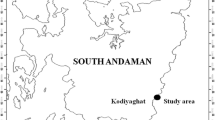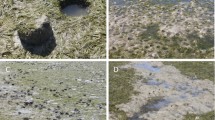Abstract
Small-scale habitat complexity, including that caused by biological structures, is an important factor in structuring benthic communities and also sometimes in increasing biodiversity. The aim of this study was to determine if hydroid colonies have an effect on the composition of benthic communities in the Irish Sea, and if so, which components of the fauna are affected. Forty-six seabed core samples were taken by divers from two sites off Port Erin, Isle of Man, Irish Sea. Half of these were centred on hydroid colonies, half were not. All taxa retained by a 63-μm sieve from the cores were identified and counted. Community composition and diversity were compared between hydroid and non-hydroid cores using multivariate and univariate methods. Benthic communities were significantly different between the two sample groups. This was almost entirely due to the presence of sessile and mobile epifaunal taxa in the hydroid cores. The tube-building amphipod, Ericthonius punctatus, was particularly abundant attached to the hydroid stems. Infauna was not significantly different between the two groups. Upright sessile epifauna may play a particularly important role in the Irish Sea as a settlement substrate for juvenile scallops (Pecten maximus and Aequipecten opercularis), which are an important fishery resource in this area. The 11-year closure of an area to dredging has not only enhanced scallop stocks but has had the added benefit of enhancing habitat complexity and biodiversity.





Similar content being viewed by others
References
Ansari ZA, Rivonker CU, Ramani P, Parulekar AH (1991) Seagrass habitat complexity and macroinvertebrate abundance in Lakshadweep coral reef lagoons, Arabian Sea. Coral Reefs 10:127–131
Auster PJ (1998) A conceptual model of the impacts of fishing gear on the integrity of fish habitats. Conserv Biol 12:1198–1203
Auster PJ, Malatesta RJ, Donaldson CLS (1997) Distributional responses to small-scale habitat variability by early juvenile silver hake, Merluccius bilinearis. Environ Biol Fish 50:195–200
Beaulieu SE (2001) Life on glass houses: sponge stalk communities in the deep sea. Mar Biol 138:803–817
Bologna PAX, Heck KL (1999) Macrofaunal associations with seagrass epiphytes—Relative importance of trophic and structural characteristics. J Exp Mar Biol Ecol 242:21–39
Bostroem C, Mattila J (1999) The relative importance of food and shelter for seagrass-associated invertebrates: a latitudinal comparison of habitat choice by isopod grazers. Oecologia 120:162–170
Bradshaw C, Veale LO, Hill AS, Brand AR (2000) The effects of scallop dredging on gravelly sea-bed communities. In: Kaiser MJ, de Groot SJ (eds) Effects of fishing on non-target species and habitats. Blackwell Science, Oxford, pp 83–104
Bradshaw C, Veale LO, Hill AS, Brand AR (2001) The effect of scallop dredging on Irish Sea benthos: experiments using a closed area. Hydrobiologia 465:129–138
Brand AR, Paul JD, Hoogesteger JN (1980) Spat settlement of the scallops Chlamys opercularis (L.) and Pecten maximus (L.) on artificial collectors. J Mar Biol Assoc UK 60:379–390
Brand AR, Allison EH, Murphy EJ (1991) North Irish Sea scallop fisheries: a review of changes. In: Shumway SE, Sandifer PA (eds) An international compendium of scallop biology and culture. World Aquaculture Society, Baton Rouge, La., pp 204–218
Collie JS, Escanero GA, Valentine PC (1997) Effects of bottom fishing on the benthic megafauna of Georges Bank. Mar Ecol Prog Ser 155:159–172
Corona A, Soto LA, Sanchez AJ (2000) Epibenthic amphipod abundance and predation efficiency of the pink shrimp Farfantepenaeus duorarum (Burkenroad, 1939) in habitats with different physical complexity in a tropical estuarine system. J Exp Mar Biol Ecol 253:33–48
Cranfield HJ, Michael KP, Doonan IJ (1999) Changes in the distribution of epifaunal reefs and oysters during 130 years of dredging for oysters in Foveaux Strait, southern New Zealand. Aquat Conserv Mar Freshw Ecosyst 9:461–483
Cummings VJ, Thrush SF, Hewitt JE, Turner SJ (1998) The influence of the pinnid bivalve Atrina zelandica (Gray) on benthic macroinvertebrate communities in soft-sediment habitats. J Exp Mar Biol Ecol 228:227–240
Dare PJ, Bannister RCA (1987) Settlement of scallop, Pecten maximus, spat on natural substrates off south west England: the hydroid connection. In: Proceedings of the 6th International Pectinid Workshop, Menai Bridge, 9–14 April 1987
Dayton PK, Thrush SF, Agardy TM, Hofman RJ (1995) Environmental effects of marine fishing. Aquat Conserv Mar Freshw Ecosyst 5:205–232
Eggleston D (1962) Spat of the scallop Pecten maximus (L.) off Port Erin, Isle of Man. In: Annual report, vol 74. Marine Biological Station, Port Erin, pp 29–32
Everett RA (1994) Macroalgae in marine soft-sediment communities: effects on benthic faunal assemblages. J Exp Mar Biol Ecol 175:253–274
Fernandez EO, Iribarne O, Armstrong DA (1994) Habitat selection by young of the year Dungeness crab Cancer magister Dana and predation risk in intertidal habitats. J Shell Res 13:291–292
Flynn AJ, Ritz DA (1999) Effect of habitat complexity and predatory style on the capture success of fish feeding on aggregated prey. J Mar Biol Assoc UK 79:487–494
Gili J-M, Hughes RG (1995) The ecology of marine benthic hydroids. Oceanogr Mar Biol Annu Rev 33:351–426
Gonzalez MJ, Downing A (1999) Mechanisms underlying amphipod responses to zebra mussel (Dreissena polymorpha) invasion and implications for fish–amphipod interactions. Can J Fish Aquat Sci 56:679–685
Grigg RW (1994) Effects of sewage discharge, fishing pressure and habitat complexity on coral ecosystems and reef fishes in Hawaii. Mar Ecol Prog Ser 103:25–34
Hall MO, Bell SS (1988) Response of small motile epifauna to complexity of epiphytic algae on seagrass blades. J Mar Res 46:613–630
Heck KL, Able KW, Roman CT, Fahay MP (1995) Composition, abundance, biomass, and production of macrofauna in a New England estuary—comparisons among eelgrass meadows and other nursery habitats. Estuaries 18:379–389
Hughes RG (1978) Production and survivorship of epizoites of the hydroid Nemertesia antennina (L.). J Mar Biol Assoc UK 58:333–345
Hughes RG (1979) The dispersal and dispersion of some epizoites of the hydroid Nemertesia antennina (L.). J Mar Biol Assoc UK 59:879–887
Isaksson I, Pihl L, Montfrans van J (1994) Eutrophication-related changes in macrovegetation and foraging of young cod (Gadus morhua L.): a mesocosm experiment. J Exp Mar Biol Ecol 177:203–217
Jennings S, Kaiser MJ (1998) The effects of fishing on marine ecosystems. Adv Mar Biol 34:201–351
Jones NS (1951) The bottom fauna off the south of the Isle of Man. J Anim Ecol 20:132–144
Jonsson LGT, Lundälv T, Johannesson K (2001) Symbiotic associations between anthozoans and crustaceans in a temperate coastal area. Mar Ecol Prog Ser 209:189–195
Kaiser MJ, Spence FE, Hart PJB (2000) Fishing gear restrictions and conservation of benthic habitat complexity. Conserv Biol 14:1512–1525
Kaiser MJK, Cheney K, Spence FE, Edwards DB, Radford K (1999) Fishing effects in northeast Atlantic shelf seas: patterns in fishing effort, diversity and community structure VII. The effects of trawling disturbance on the fauna associated with the tubeheads of serpulid worms. Fish Res 40:195–205
Klitgaard AB (1995) The fauna associated with outer shelf and upper slope sponges (Porifera, Demospongiae) at the Faroe Islands, northeastern Atlantic. Sarsia 80:1–22
Lee SY, Kneib RT (1994) Effects of biogenic structure on prey consumption by the xanthid crabs Eurytium limosum and Panopeus herbstii in a salt-marsh. Mar Ecol Prog Ser 104:39–47
Lee SY, Fong CW, Wu RSS (2001) The effects of seagrass (Zostera japonica) canopy structure on associated fauna: a study using artificial seagrass units and sampling of natural beds. J Exp Mar Biol Ecol 259:23–50
Lindholm JB, Auster PJ, Kaufman LS (1999) Habitat-mediated survivorship of juvenile (0-year) Atlantic cod Gadus morhua. Mar Ecol Prog Ser 180:247–255
Lindholm JB, Auster PJ, Ruth M, Kaufman L (2000) Modeling the effects of fishing and implications for the design of marine protected areas: juvenile fish responses to variations in seafloor habitat. Conserv Biol 15:424–437
Magorrian BH, Service M (1998) Analysis of underwater visual data to identify the impact of physical disturbance on horse mussel (Modiolus modiolus) beds. Mar Pollut Bull 36:354–359
Martin-Smith KM (1993) Abundance of mobile epifauna: the role of habitat complexity and predation by fishes. J Exp Mar Biol Ecol 174:243–260
McMillan RO, Armstrong DA, Dinnel PA (1995) Comparison of intertidal habitat use and growth rates of two northern Puget Sound cohorts of 0+ age Dungeness crab, Cancer magister. Estuaries 18:390–398
Moore PG, Cameron KS (1999) A note on a hitherto unreported association between Photis longicaudata (Crustacea: Amphipoda) and Cerianthus lloydii (Anthozoa: Hexacorallia). J Mar Biol Assoc UK 79:369–370
Nagelkerken I, Kleijnen S, Klop T, Brand RACJ van den, de la Moriniere EC, Velde G van der (2001) Dependence of Caribbean reef fishes on mangroves and seagrass beds as nursery habitats: a comparison of fish faunas between bays with and without mangroves/seagrass beds. Mar Ecol Prog Ser 214:225–235
Nalesso RC, Duarte LFL, Pierozzi I, Enumo EF (1995) Tube epifauna of the polychaete Phyllochaetopterus socialis Claparede. Estuar Coast Shelf Sci 41:91–100
Platell ME, Potter IC (1996) Influence of water depth, season, habitat and estuary location on the macrobenthic fauna of a seasonally closed estuary. J Mar Biol Assoc UK 76:1–21
Quinn TP, Peterson NP (1996) The influence of habitat complexity and fish size on over-winter survival and growth of individually marked juvenile coho salmon (Oncorhynchus kisutch) in Big Beef Creek, Washington. Can J Fish Aquat Sci 53:1555–1564
Ragnarsson SA, Raffaelli D (1999) Effects of the mussel Mytilus edulis L. on the invertebrate fauna of sediments. J Exp Mar Biol Ecol 241:31–43
Reise K, Schubert A (1987) Macrobenthic turnover in the subtidal Wadden Sea: the Norderaue revisited after 60 years. Helgol Meeresunters 41:69–82
Turner SJ, Thrush SF, Hewitt JE, Cummings VJ, Funnell G (1999) Fishing impacts and the degradation or loss of habitat structure. Fish Manage Ecol 6:401–420
Vehanen T, Bjerke PL, Heggenes J, Huusko A, Maeki-Petaeys A (2000) Effect of fluctuating flow and temperature on cover type selection and behaviour by juvenile brown trout in artificial flumes. J Fish Biol 56:923–937
Watling L, Norse EA (1998) Disturbance of the seabed by mobile fishing gear: a comparison to forest clearcutting. Conserv Biol 12:1180–1197
Woodin SA (1978) Refuges, disturbance, and community structure: a marine soft-bottom example. Ecology 59:274–284
Acknowledgements
Thank you to K. Ramsay for helping with the diving and L. Veale for identifying the worms. This study was carried out under the umbrella of a project funded by U.K. Ministry of Agriculture, Fisheries and Food (grant number CSA 4142). Continuing thanks also to the Isle of Man Department of Agriculture, Fisheries and Forestry scallop research project, which supports the closed area.
Author information
Authors and Affiliations
Corresponding author
Additional information
Communicated by J.P. Thorpe, Port Erin
Rights and permissions
About this article
Cite this article
Bradshaw, C., Collins, P. & Brand, A.R. To what extent does upright sessile epifauna affect benthic biodiversity and community composition?. Marine Biology 143, 783–791 (2003). https://doi.org/10.1007/s00227-003-1115-7
Received:
Accepted:
Published:
Issue Date:
DOI: https://doi.org/10.1007/s00227-003-1115-7




